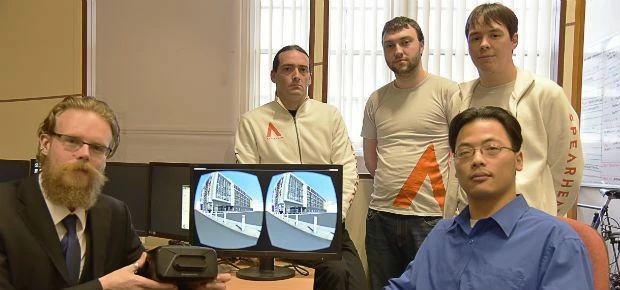
Partner Article
Teesside technology firm Spearhead Interactive go global following national success
Teesside-based Spearhead Interactive is planning on exporting its cutting edge products to clients in Japan and Brazil to build upon its success in this country.
The company, which was formed with the help of a DigitalCity Fellowship, is using technology from the world of gaming to develop applications for businesses, educators and governments to use.
Software developed by Spearhead ranges from interactive assembly and operational guides for products and components, through to digital replicas of buildings and environments.
DigitalCity, which is based at Teesside University and funded by the European Regional Development Fund, offers Fellows up to £4,000 to cover their living costs while they develop a business product or idea and also provides expert mentoring and support, as well as access to state-of the-art equipment.
Spearhead founders Dan Riley and Paul Li lead a team of developers based at a business incubator in the Victoria Building at Teesside University.
Dan recently visited the Tokyo Games Show to demonstrate Spearhead’s software to a public audience, in conjunction with the Virtualizer, an omni-directional treadmill built by Austrian company Cyberith and also attended meetings with the Tokyo Metropolitan Government regarding expanding the business into Japan.
The software developed by Spearhead and the novel use of the technology used to create it has attracted interest from a games console manufacturer and several large Japanese-based firms including Sony and Samsung who are all set to release their own VR hardware in 2015.
Thanks to the Enterprise Europe Network (EEN) North East which is led by Teesside University, Dan was also put in contact with EEN representatives in Brazil to discuss potential opportunities to develop new markets in the country.
He said: “For virtual reality, we believe there are four key elements to creating a virtual digital experience which replicates the way we interact with the real-world; the presence within the virtual world, the ability to move around it, the ability to interact with it and the ability to feel it.
“To achieve all of this we are working with some of the most hi tech equipment around from headsets and treadmills, to body and finger tracking systems alongside haptic feedback suits and exo-skeletons. We’re also conducting R&D into environmental stimulation such as heat lamps and fans.
“VR is simply another way to access and experience real-time 3D software, which we’re already developing for PC, Mac and mobile devices. The main focus of the technology is to provide access to data in the context in which it would typically exist. Using 3D you are able to better convey ideas, by integrating data you are able to better understand the concepts, and by using real-time technologies, user are able to better experience these ideas.
“We’re certainly operating at a very high level in this field and with digital, we have a global reach, so it’s fantastic that our work has already been positively received abroad.”
This was posted in Bdaily's Members' News section by Ellen Forster .
Enjoy the read? Get Bdaily delivered.
Sign up to receive our daily bulletin, sent to your inbox, for free.








 Zero per cent - but maximum brand exposure
Zero per cent - but maximum brand exposure
 We don’t talk about money stress enough
We don’t talk about money stress enough
 A year of resilience, growth and collaboration
A year of resilience, growth and collaboration
 Apprenticeships: Lower standards risk safety
Apprenticeships: Lower standards risk safety
 Keeping it reel: Creating video in an authenticity era
Keeping it reel: Creating video in an authenticity era
 Budget: Creating a more vibrant market economy
Budget: Creating a more vibrant market economy
 Celebrating excellence and community support
Celebrating excellence and community support
 The value of nurturing homegrown innovation
The value of nurturing homegrown innovation
 A dynamic, fair and innovative economy
A dynamic, fair and innovative economy
 Navigating the property investment market
Navigating the property investment market
 Have stock markets peaked? Tune out the noise
Have stock markets peaked? Tune out the noise
 Will the Employment Rights Bill cost too much?
Will the Employment Rights Bill cost too much?